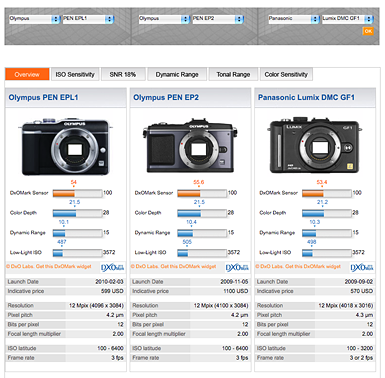Olympus E-PL1 at DxO Mark
April 1, 2010
DxO Labs have released their sensor test results for Olympus’s “econo” Pen model, the E-PL1.
Their tests show it having slightly worse high-ISO performance than its competitors in the “compact EVIL” segment.
The entire selling point of Micro Four Thirds is that the larger sensor offers improved picture quality, relative to typical compact cameras. DxO Mark’s “Low-Light ISO” score is expressed in ISO sensitivity numbers; and here they report that noise becomes objectionable at around ISO 500.
But the overall “DxO Mark Sensor” score falls much closer to that of a modern compact camera than to that of a good recent DSLR.
This is a disappointment, given the extra time Olympus had for developing the E-PL1; and also compared to the dramatically-better performance of its Micro Four Thirds cousin, the Panasonic GH1.
As always, note that DxO Labs tests are entirely “numbers oriented” and only analyze the raw sensor data. Handling, price, the quality of in-camera JPEG processing, etc. are not considered.

April 12, 2010 at 12:00 am
Hi,
I love this blog’s take on the technical details of lenses and chips. Can you touch on how cameras reduce their MP “resolution”? i.e. my Canon XSi at 12MP can take pictures as 6MP. Is it ignoring pixels or averaging across pixels? Is there anything to gain, noisewise?
April 12, 2010 at 12:36 am
That’s a question that’s been asked several times. Fundamentally, the amount of noise is a result of the sensor dimensions (see the discussion here), rather than the pixel count.
In JPEG, you can let the camera downsample the image, or do it later yourself, and it’s probably a wash. If you shoot in raw, though, using the full-resolution image gives you more flexibility to fine-tune the NR and downsampling to suit each particular image.
April 27, 2010 at 2:52 pm
Ah, so it’s done in post-processing in-camera, not by summing signal from neighbor pixels together before processing. Downsampling from RAW does sound like a better idea.
May 19, 2010 at 8:14 pm
[…] four thirds, micro 4/3, micro four thirds, MILC, Nikon, noise, Olympus Pen, Petavoxel, sensor Petavoxel recently bemoaned the fact that the majority of sensors in recent micro four thirds EVIL cameras (or MILCs, if you […]